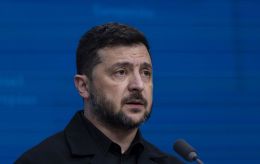Why Trump still can't stop war: US plan for Ukraine 'failed'
 Negotiations in London (photo: Getty Images)
Negotiations in London (photo: Getty Images)
The United States has failed to persuade Ukraine and Europe to make radical concessions to Russia in negotiations to end the war.
RBC-Ukraine reports on the main developments in recent negotiations and explains the differences between the various “peace plans.”
The United States has failed to persuade Ukraine and Europe to make radical concessions to Russia in negotiations to end the war.
RBC-Ukraine reports on the main developments in recent negotiations and explains the differences between the various “peace plans.”
Key points:
-
Why the talks in London did not go as planned
-
What Ukraine and Europe are proposing compared to the US
-
How Trump’s rhetoric on negotiations is changing
London meeting and Rubio’s demarche
This week, the active phase of negotiations involving the US, Ukraine, and European countries continued. Following a series of meetings in Paris on April 16–18, a new multilateral meeting at the level of foreign ministers was scheduled to take place in London on April 23.
According to Axios, the United States had hoped to receive Ukraine’s response to US President Donald Trump’s “final proposals” during the London meeting. If the response had been positive, the proposals were to be forwarded to Russia.
However, at the last moment, US Secretary of State Marco Rubio refused to attend. As a result, the foreign ministers of European countries also canceled their participation. Only a meeting at the level of advisors was held.
According to CNN, Rubio’s withdrawal was triggered by Ukrainian President Volodymyr Zelenskyy’s refusal to accept the recognition of Russia’s occupation of Crimea — one of the key elements in Trump’s “final proposals.”
On April 22, Zelenskyy stated that he was open to negotiations with Russia, but Ukraine would not accept any deal that recognized Russia’s control over Crimea.
“Ukraine will not legally recognize the occupation of Crimea. There is nothing to discuss. It contradicts our Constitution,” the Ukrainian president said.
US, Ukrainian and European plans
Ahead of the London meeting, details of what the United States had offered Ukraine appeared in a number of American media outlets. The most comprehensive version, published by Reuters, envisaged a permanent ceasefire: the parties were to immediately begin negotiations on its technical implementation.
In return, Ukraine would receive reliable security guarantees. These would be provided by European countries and willing non-European states. At the same time, Ukraine would forgo NATO membership but could pursue accession to the European Union.
In addition, the US would legally recognize the occupation of Crimea and, de facto, the occupation of Luhansk, as well as parts of the Zaporizhzhia, Donetsk, and Kherson regions. In return, Ukraine would regain territory in the Kharkiv region and reestablish control over the Kakhovka Hydroelectric Power Plant, while the US would take control of the Zaporizhzhia Nuclear Power Plant. Ukraine would also gain unrestricted navigation along the Dnipro River and control over the Kinburn Spit.
The plan further envisioned the implementation of a critical minerals agreement between the US and Ukraine, with Kyiv receiving funding for reconstruction. However, it also included the lifting of all sanctions imposed on Russia since 2014. Additionally, Washington and Moscow would resume economic cooperation.
At the same time, during the London negotiations with European partners, Ukraine developed its own version of a plan to end the war, which was immediately submitted to the Americans.
Various versions of what was included in the Ukrainian-European plan appeared in Western media. RBC-Ukraine sources point to the version published by Reuters as the one most closely reflecting reality.
It clearly highlights the significant differences between the American vision on one side and the Ukrainian-European one on the other.
In particular, regarding the ceasefire, Ukraine and Europe propose a mechanism for monitoring the truce, to be led by the United States with support from third countries.
On security guarantees, the main difference is that Ukraine does not agree to forgo NATO membership, as demanded by the Americans (and the Russians). Instead, until Ukraine joins the Alliance, it should receive strong security guarantees similar to NATO’s collective defense — including from the US. Ukraine and Europe also reject any restrictions on the size or armament of the Ukrainian Armed Forces.
There are also major differences concerning territorial issues. Ukraine and Europe do not want to discuss the legal or de facto recognition of any territories as Russian at this stage. All matters related to territorial control are to be resolved only after a full and unconditional ceasefire, with the current line of contact serving as the basis.
Unlike the US, Europe and Ukraine oppose the lifting of all sanctions imposed on Russia since 2014. They only allow for a gradual easing of sanctions once sustainable peace is achieved — with an option to reinstate them if Russia violates the peace agreement.
However, Ukrainian Foreign Ministry spokesperson Heorhii Tykhyi stated that most media publications about the "peace plans" do not reflect reality. At the same time, Ukraine insists on three core principles for ending the war:
-
Ukraine will never recognize any part of its territory as Russian;
-
Ukraine will never accept any restrictions on its armed forces, defense forces, defense capabilities, defense industry, or military assistance from its partners;
-
No third country has a veto over Ukraine’s choice of alliances and partnerships.
Strike on Ukraine and Trump’s warning
On April 23, Donald Trump stated that President Zelenskyy's remarks regarding Crimea were harming peace talks with Russia, as the peninsula had been "lost" many years ago under then-US President Barack Obama and was no longer a subject of discussion.
“No one is demanding that Zelenskyy recognize Crimea as Russian territory, but if he wants Crimea, why didn’t they fight for it eleven years ago when it was handed over to Russia without a single shot being fired?” Trump wrote on his Truth Social platform.
Against this backdrop, Russia launched a new large-scale attack on Ukraine, with a significant share of missiles and drones targeting Kyiv.
Responding to the strikes, Trump publicly addressed Putin for the first time in a long while.
“I am unhappy with Russia’s strikes on Kyiv. They are unnecessary and very poorly timed. Vladimir, stop! Five thousand soldiers are dying every week. Let’s make a peace deal!” Trump wrote.
According to The Wall Street Journal, Donald Trump has recently been frustrated that Putin has not shown greater flexibility. The question now is whether the US president is prepared to put pressure on Moscow to make major concessions for a deal, just as he has been urging Ukraine to do.
Another meeting between Witkoff and Putin
It appears that the document received by the Americans from Ukraine and Europe was reviewed in Washington, and afterward, on April 25, Trump’s special representative for Russia and the Middle East, Steve Witkoff, made another — his fourth — trip to Moscow.
Ahead of the meeting, Bloomberg reported that the United States would insist that Russia recognize Ukraine’s right to maintain its own army and defense industry as part of a peace agreement between Moscow and Kyiv.
As usual, there was little concrete information following the talks between Witkoff and Putin. Russian officials only emphasized that the conversation was “constructive” and “very useful.” “Among other things, the discussion touched on the possibility of resuming direct negotiations between representatives of Russia and Ukraine,” said Yuri Ushakov, an aide to the Russian dictator.
Progress on a minerals agreement
Amid other developments, a visit by Ukrainian Prime Minister Denys Shmyhal to the United States went largely unnoticed but was significant for Kyiv. The main purpose of the trip was negotiations on a minerals agreement together with US Treasury Secretary Scott Bessent.
“Our negotiating teams are continuing active work, as outlined in the signed memorandum (signed on April 18),” Shmyhal said following the talks.
According to him, key political aspects of the future agreement were discussed.
“I also emphasized that under Ukrainian law, the agreement must be ratified by the Verkhovna Rada. We agreed to begin work on a free trade zone between Ukraine and the United States,” Shmyhal noted.
For his part, Ukraine’s Finance Minister Serhiy Marchenko said that Kyiv and Washington had made progress on the agreement but would not finalize it this week.
“Progress has been made, and our teams are now working very closely together. There are still some issues under discussion,” Marchenko said.
Specifically, he noted that US Treasury Secretary Scott Bessent wants the issue of frozen Russian assets to be part of broader talks. Trump, for his part, is demanding that Ukraine sign the agreement “immediately.”
However, it is clear that for Ukraine, this only makes sense in the context of broader negotiations to end the Russia-Ukraine war and will depend on how those talks progress.
***
Judging by the number of comments, statements, media leaks, meetings, and other diplomatic activities, the past week was likely the most intense since Donald Trump began his efforts to “broker peace” between Ukraine and Russia.
However, as of now, the prospects and format for ending the war remain as unclear as ever. It is evident that Ukraine and key European countries — France, the United Kingdom, and Germany — have largely managed to align their positions, which differ significantly from that of the United States. The US stance, while notably more favorable to Russian interests, also diverges from Moscow’s vision.
The framework for starting a ceasefire, territorial issues, and post-war security guarantees for Ukraine — no visible compromise has yet emerged on any of these crucial topics. Predicting the situation remains especially difficult given that the central participant — the United States — changes its public position almost daily. For instance, as recently as Thursday, Trump spoke about a firm “deadline” for a peace deal. Yet by Friday, it became clear that he no longer saw any deadline.
Although the American president claimed that “most key points” of the peace agreement had already been agreed upon, the real situation appears to be quite different.
Nevertheless, important updates on the peace process could emerge soon — during Trump’s visit to Europe, which begins today.

